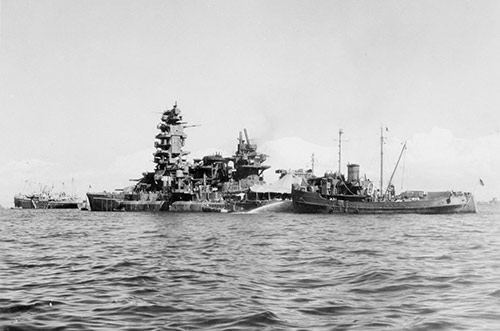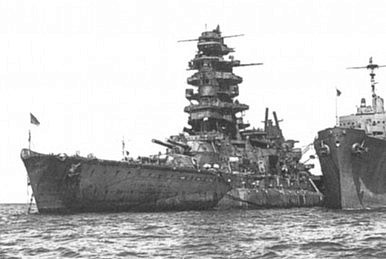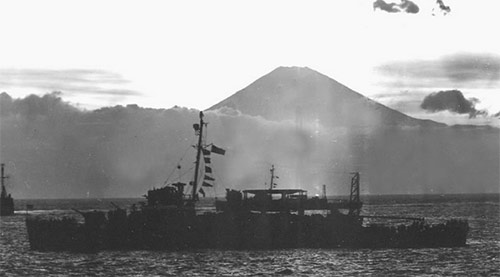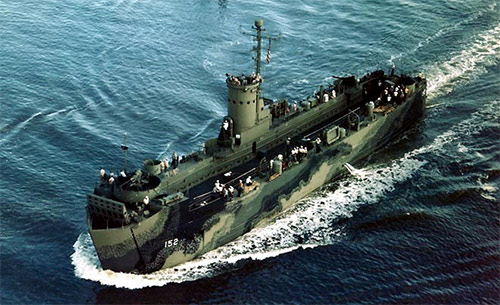Whipple Takes Command

Captain Whipple wisely decided not to try to remake his pirate crew all at once, but rather to develop the good qualities they already had along his own lines. He offered no illusory inducements nor did he apply abruptly the harsh break of punishment. The officers learned that though direct orders did not get results, indirect effort could; that to actually start on a necessary task on deck would bring dozens of willing hands without call; that when a demonstrated need arose; materials would be forthcoming. The men continued to anticipate the basic needs of the undertaking; when a shack to protect against the elements was needed on the navigation bridge; it appeared without anyone mentioning the fact.
Certainly it was not just what I would have designed; but perhaps it worked a little better for that. When a boom was needed to accommodate the hoisting of an entire Mike boat, we got it; when there had to be a table in the galley; one appeared; the old Japanese laundry was put into operation without benefit of orders.
Gradually, our morning muster formations became more military, the gangway watch more alert. By an expression of appreciation here, a deft, well-timed flick of discipline there, and much human give-and-take all round, a rabble of opportunists was transformed into a passable ship’s company. The crew was never up to man-of-war standards, but the events that unfolded were to prove that it was good enough.

(USS Delta alongside ex-IJN Nagato in Yokosuka harbor, 1945. Photo USN).
In the way of material things, our main support was the USS Delta (AR-29), a new, well-equipped repair ship that tied up alongside shortly before Captain Whipple came aboard. Her crew was military, her decks clean, with so much fresh paint around as to be an unmitigated nuisance. Delta was the lead ship of a new class of repair ships. She had been laid down originally as a merchantman, as SS Hawaiian Packer before her requisition by the U.S. Navy in 1941. Before conversion to a repair ship, Delta briefly served as a Navy auxiliary, AK-29. The officers of the Nagato, and nominally the men as well, lived aboard her as long as she was with us. Most of the men actually preferred to stay in Nagato, since they had occupied the better staterooms and enjoyed the portholes that let in fresh air.

Life in the Delta was not bad. We were in the inner harbor of Yokosuka. On a pre-breakfast stroll on deck in hard, clear weather we could watch the searching fingers of the rising sun rub color on the immaculate cone of Fuji to the south. The lack of any industrial activity on the Kanto Plain left the skies clear and white-washed. There were plenty of boats available; we could get ashore any afternoon to the luxury of the former Japanese Officers’ Club on the lush green hill and gather with old friends from all parts of the world to shoot the breeze. A month passed quickly as we grappled with many problems.
Those were not easy. My notebook filled with lists of things we needed. At higher levels it had been decided that we should have only an absolute minimum of repairs and supplies to fit us for sea and the voyage to the demonstration at Bikini Atoll. I listed patiently at the naval pre-sail conferences where absolutely essential items were stricken from the list. It was at this time that a proper divergence arose between Captain Whipple and myself. A Captain has to take a broad view embracing the good of the service at large, the interests of the United States, and possibly of the world.
I was lucky. The Executive Officer, the XO, is under no such obligation. He can and must be strictly partisan in regard to the needs of his ship. So it was that I never batted an eye when Captain Whipple agreed in conference to sail with only one sextant and two pairs of binoculars. This was clearly inadmissible. Suppose someone dropped the sextant or hid the binoculars? Even a tramp steamer would never sail with so little equipment and lack of redundancy. Another sextant and more binoculars came aboard – how that happened doesn’t matter to the Nagato Navy – and I kept them hidden for a while, but that didn’t seem right. A captain is supposed to know what is going on in his ship, and when I told him, sheepishly, Captain Whipple just laughed at me – said he knew all along I wouldn’t sail with just one sextant.

(An LSM of the class that Nato’s pirate crew cannibalized to improve their quality of life. colorized photo USN).
It was about this time that an LSM who had broken her back on a reef was towed in and tied up alongside us. We boarded her with a work party and acetylene torches. Everything we could use came off. We even ran the officers out of the wardroom to take their bedding and silverware. Besides navigational and signal gear, we got kitchen utensils, drinking fountains, canned goods and a ton of potatoes. We had to push the yeoman off his stool to take that, his typewriter, file cases and desk lamp. The last I intended for the captain’s cabin, but it disappeared before reaching our deck, appearing some weeks later in the signal shack. I decided to leave well enough alone. A crew from the cruiser Sakawa, which would accompany us to the southern ocean, came late. We let them have a washing machine and some butcher knives.
Such minor items as the whistle were the subject of much effort and tedious conferences. The Japanese had cut away the old one with the top of the mast and we never found it. The Delta installed a little tin dingus up there – it would give a feeble beep when you pulled the cord. That is just the wrong thing a vessel approaching in a fog would think she had to do with a motor boat and rely on its getting out of the way instead of making frantic efforts to get clear as she would from a battleship. It was indignantly rejected. We searched the Japanese Navy Yard, turning up a big brass device of uncertain purpose.
The Delta first claimed she could not mount it, then went on to complain that she had. Then we complained when it could not blow. The fact was that we could never manage to get enough steam up to it. After interminable adjustments and rearrangement of pipes, we dropped the matter. At sea we never know what would happen when we pulled the cord – sometimes a mighty bovine roar, but more likely just a festive belch.
Many times each sunny day as I clambered over the rusty bulk of the Nagato checking lines, boats, laborers, supplies and efforts, I paused to admire the busy life of the harbor. Against a background of hammerhead cranes and repair shops, battleships and cruisers lay close in to the beach. Off to the north was a bustling Marine airfield. Eager faces lined the faces of incoming ships, getting their first glimpse of Mt. Fuji to the south. Other ships steamed grotesque going-home pennants supported by balloons. In and out among the shipping hurried the Japanese tugs SO SORRY and EXCUSE PLEASE.
As I became used to the scene and more able to appreciate fine points, a small American tug became a fascinating object. Apparently she had no home, but would tie up to anything solid, including the Nagato. Like as not, I would see her riding on our port quarter. Her own men handled her lines aboard the Nagato without speaking to anyone and then retired to the privacy of the tug’s deckhouse. You might observe her at rest, idling, then now darting off, unpredictable and capricious. Without her, the picture would have been inartistic. She added just the right touch of mystery.
At first all of us based our hopes on aid from the Delta. Her people were eager to show her what they could do with a Japanese battleship; but the task soon proved not only far too large, but most discouraging. Partially it was the metric system of measurement used by the Japanese ship-builders, which made the duplication of a necessary part take six times as long as usual; partly it was the sheer bulk of the Nagato; partly her poor lighting systems; but mainly it was the discomfort of working in dank, oil-coated spaces. Officers and men soon lost their enthusiasm, began to urge the view that they were there mostly as advisors, and that the actual work should be done by the pirate crew of the Nagato, which numbered only one-tenth as many as the original Japanese crew. It was soon apparent that the ship must steam as she was, if she was to steam at all.
The only thing to do was raise steam, open the throttle, and see what happened.
Copyright 2015 Vic Socotra
www.vicsocotra.com
Twitter: @jayare303
